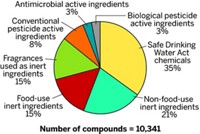Advertisement
Grab your lab coat. Let's get started
Welcome!
Welcome!
Create an account below to get 6 C&EN articles per month, receive newsletters and more - all free.
It seems this is your first time logging in online. Please enter the following information to continue.
As an ACS member you automatically get access to this site. All we need is few more details to create your reading experience.
Not you? Sign in with a different account.
Not you? Sign in with a different account.
ERROR 1
ERROR 1
ERROR 2
ERROR 2
ERROR 2
ERROR 2
ERROR 2
Password and Confirm password must match.
If you have an ACS member number, please enter it here so we can link this account to your membership. (optional)
ERROR 2
ACS values your privacy. By submitting your information, you are gaining access to C&EN and subscribing to our weekly newsletter. We use the information you provide to make your reading experience better, and we will never sell your data to third party members.
Policy
Animal Testing Alternatives
July 30, 2007
| A version of this story appeared in
Volume 85, Issue 31
C &EN missed an opportunity to address a critical national need, accelerated validation of animal testing alternatives, when it published two stories—"Animal Testing Alternatives" and "EPA Unveils Testing List"—on closely related topics (C&EN, June 18, pages 12 and 13). The National Research Council report "Toxicity Testing in the Twenty-First Century: A Vision and a Strategy" provides a useful vision.
In my opinion, the report has two deficiencies. First, it should have emphasized the essential complementary role of in vitro and whole animal tests. Second, it should have more clearly outlined a strategy for developing and validating the in vitro tests advocated in the report. It is necessary to demonstrate that the in vitro tests are actually predictive of human toxicity, not merely substitutes for toxicity tests in animals.
The NRC report falls short in not articulating a strategy that includes acquisition of in vitro test data on known human toxicants. Then these new tests must be formally validated. In 1997, the National Institute of Environmental Health Sciences established the Interagency Coordinating Committee on the Validation of Alternative Methods (ICCVAM) to carry out several functions, including oversight of test method validation. The committee, with representatives from 15 agencies, including the Environmental Protection Agency, was made permanent in 2000 with passage of the ICCVAM Authorization Act. During the past decade, only a few alternative tests have been validated in the U.S. Much more progress has been made in Europe.
The second article, "EPA Unveils Testing List," relates that more than a decade has gone by since concerns were raised about endocrine-disrupting properties of chemicals. During that decade, EPA has not validated a single Tier 1 test, the tests EPA now proposes for use as quick screens in evaluating 73 chemicals for endocrine-disrupting properties.
There is a clear disconnect between EPA requesting preparation of the NRC report on the future of toxicity testing and the agency's failure to proceed with validation of the screening tests it is now proposing to use. The use of nonvalidated screening procedures is likely to result in continued controversy over potential endocrine-disrupting properties of chemicals.
EPA needs to move its proposed Tier 1 test methods through the ICCVAM process. Validation of these tests can serve as a prototype for validation of other toxicity tests necessary for achieving the vision outlined in the NRC report.
Roger O. McClellan
Albuquerque, N.M.



Join the conversation
Contact the reporter
Submit a Letter to the Editor for publication
Engage with us on Twitter